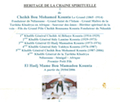Qadiri Community of Buh Kunta
By Maria Grosz-Ngate and Toba Diagne Haїdara
Islam in Senegal is often portrayed as dominated by two Sufi orders, the Muridiyya associated with Shaykh Amadu Bamba and several branches of the Tijaniyya. But there are in fact other Sufi groups, of which several belong to the oldest Sufi order in all of West Africa, the Qadiriyya. One of these bears the name of the most famous Qadiri lineage, the Kunta. We introduce here the vibrant Muslim community of Buh Kunta, which began before the Muridiyya and the Tijaniyya of El Haj Malick Sy.
The Qadiri community of Shaykh Buh Kunta originated in 1883 when Abu (“Buh”) Muhammed ben Abu Naama Kunta, a descendant of the prestigious Kunta family, established himself in Ndiassane, Senegal, with a small group of followers. French colonial expansion into the West African interior and the promotion of peanut production brought about significant population movements during this period. Many people of different ethnic backgrounds were drawn to Shaykh Buh by economic opportunity and by his reputation for piety and generosity, his mystical powers, and his gifts as a healer.
Located about eighty kilometers east of Dakar, the small town of Ndiassane has become the spiritual center for far-flung networks of followers. The highlight of the year is the annual pilgrimage when thousands of members from Senegal, Gambia, Guinée, and Mali converge on Ndiassane to seek blessings. Many active adherents are women, and some have been named “Shaykh” in recognition of their devotion and service.
This gallery presents audio interviews with Kunta family members and followers, images, and documents (including newspaper articles) to illuminate the history and contemporary dynamics of this Qadiri community.



